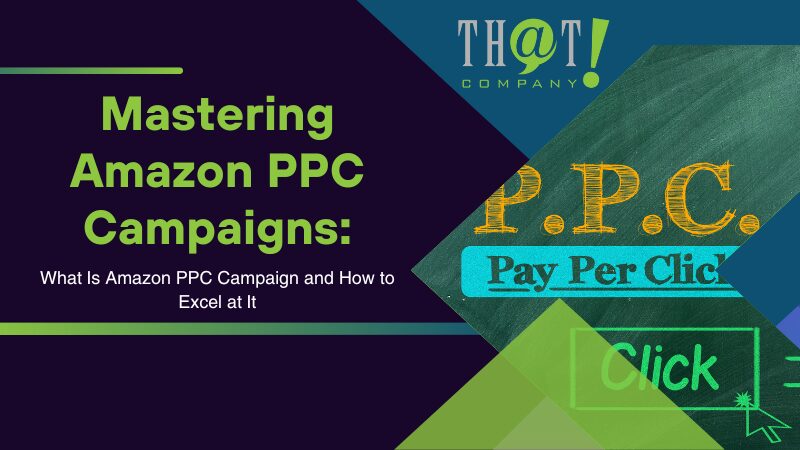
Imagine having the power to place your product in front of millions of potential customers precisely when they’re looking for it. Enter “What is Amazon PPC campaign”! A powerful tool, Amazon PPC (Pay-Per-Click) campaigns put your product in the spotlight, driving more traffic and ultimately more sales. So, where to start? Buckle up as this journey will take you from understanding the basics to mastering the art of “what is Amazon PPC campaign.”
Key Takeaways
- Amazon PPC campaigns are a cost-effective advertising strategy where sellers bid on keywords and pay for each ad click, which can be managed using tools like Amazon Seller Central and include metrics such as ad spend, cost per click, and conversion rates.
- Successful Amazon PPC campaigns require effective keyword research, selecting the right ad types (Sponsored Products, Sponsored Brands, and Sponsored Display), and strategic bidding to balance visibility and cost, leading to optimized ROI.
- Scaling Amazon PPC campaigns involves experimenting with ad types and targeting, aligning with seasonal trends and promotions, and potentially outsourcing management to agencies like That! Company to grow reach and sales while avoiding common mistakes like poor keyword selection and inadequate budget management.

Understanding Amazon PPC Campaigns
Amazon presents its third-party sellers with a potent tool known as Amazon PPC. It allows them to create personalized ad campaigns for their products, enhancing visibility and reaching millions of potential customers. Essentially, the way it works is through an auction system. Sellers bid on keywords, and the highest bidder displays their ad to potential customers. This system enhances your product’s visibility, and the cost incurred only when a shopper clicks on your ad, which is why it’s called Pay-Per-Click (PPC). You can effectively manage your Amazon PPC campaigns and optimize your ad performance using Amazon Seller Central.
There are several PPC ad types on Amazon: Sponsored Products, Sponsored Brands, and Sponsored Display ads. Each type is designed to serve different purposes and strategies for sellers. For instance, Sponsored Brands ads allow you to promote multiple products simultaneously with improved visuals. Moreover, you have certain key metrics to understand the performance of your Amazon PPC campaigns, which include ad spend against sales, impressions, cost per click, and conversion rate. So, you’re not shooting in the dark. You have measurable metrics to gauge how your campaigns are performing.
What is an Amazon PPC campaign?
At its core, a PPC ad campaign on Amazon is an advertising strategy where sellers pay a fee each time their ad is clicked. Consider buying visits to your product listing rather than obtaining them organically. One of the most common types of Amazon PPC ads is Sponsored Products. These ads are designed to promote a single product and can appear on desktop and mobile devices. An Amazon PPC strategy aims to maximize visibility and sales by ensuring your product ads appear in the search results when potential buyers search for similar products.
One of the key advantages of Amazon PPC is its flexibility. You can set a daily budget, choose where your ads will appear, and select specific keywords for targeting. This level of control allows you to tailor your campaign to meet your business needs and reach your target audience more effectively. Moreover, getting started with Amazon PPC is quite affordable, making it an accessible marketing tool for sellers of all sizes.
How does Amazon PPC work?
You may ask how Amazon PPC operates. Well, it’s all about keywords and bidding. Sellers bid on relevant keywords, and Amazon’s algorithm selects the highest bid to display the corresponding ad to potential customers. This is where the term ‘cost-per-click’ (CPC) comes into play, an essential aspect of advertising cost. It is the amount a seller pays each time a potential buyer clicks on their ad. Understanding Amazon PPC costs is crucial, as the average cost per click can vary greatly, with rates ranging from $0.10 to $6.00 USD.
What’s interesting, Amazon PPC operates on a second-price auction model. In this model, the winning bidder pays the amount bid by the second-highest bidder, not their maximum bid, for a click. Several factors affect the overall expenditure of an Amazon PPC ad, such as the bid amount, the competition level for the chosen keywords, and the ad’s relevance to the search query. This means you have control over your ad expenditure by strategically selecting your keywords and bids.
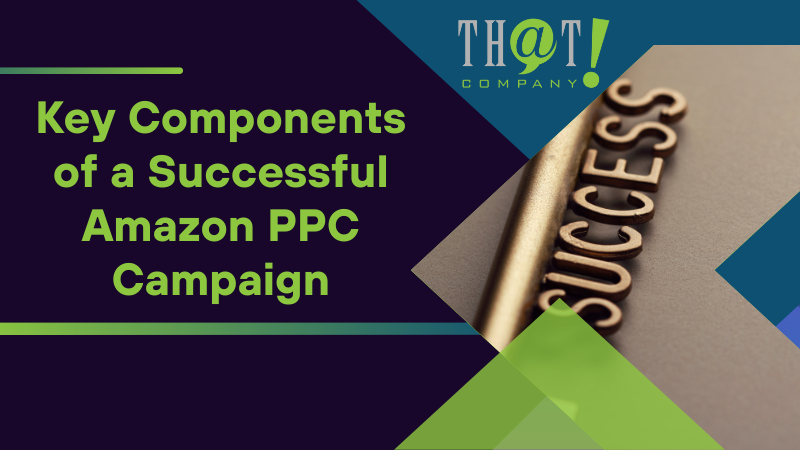
Key Components of a Successful Amazon PPC Campaign
Think of a successful Amazon PPC campaign as a well-coordinated machine with multiple components functioning in unison. At this machine’s heart are key components: keyword research, ad types, and bidding strategies. Understanding and effectively leveraging these elements can significantly enhance the efficiency and success of your Amazon PPC campaign.
Keyword research involves pinpointing relevant and high-yielding keywords for your campaign. It is crucial as it ensures that your product listings are properly optimized, maximizing the effectiveness of your advertising investment. The choice of ad types is also essential. Amazon provides a variety of ad types like Sponsored Products, Sponsored Brands, and Sponsored Display ads, each serving different purposes and strategies. Lastly, bidding strategies play a significant role. They help you balance potential returns and ad spend, optimizing your campaign’s profitability.
Keyword Research
Effective keyword research forms the bedrock of any successful Amazon PPC campaign. It involves identifying the terms potential buyers use when searching for products similar to yours. Several tools, such as Keywords Everywhere and Sonar, can assist you in conducting keyword research.
A comprehensive list of relevant keywords increases your chances of reaching a wider audience and driving sales. One useful tool for expanding your keyword list is Keyword Scout. It allows you to review data such as the keywords for which your competitor’s product ranks. You can download this data and organize it according to your specific needs. This way, you’re targeting consumers who are using common search terms and those using terms your competitors might not have thought of.
Ad Types
Selecting the appropriate ad type for your campaign resembles picking the suitable tool for a task. Amazon PPC offers a variety of ad types, each with unique benefits and functions. For instance, Sponsored Product ads are the most common type of Amazon PPC ad, utilized by 70% of third-party sellers. These ads are designed to promote individual product listings, making them ideal for enhancing the visibility of individual products.
On the other hand, Sponsored Brand ads are known for generating the highest sales among all PPC types. Sellers can experiment with different types of ads to assess their effectiveness. After gathering sufficient data, they can eliminate underperforming ads and optimize those delivering positive results. This way, they can ensure that their ad type selection aligns with their marketing goals and target audience.
Bidding Strategies
Bidding strategies serve as the driving force behind your Amazon PPC campaign. They determine how your ad budget is spent and can significantly impact your campaign’s performance. One approach is dynamic bidding, where Amazon’s algorithm modifies your bid based on the likelihood of the potential click resulting in a sale. It’s an excellent strategy for sellers who prefer a more hands-off approach and don’t need precise control over their ad placements.
The exact match bidding strategy ensures that your ad will be displayed only when a user searches using the keyword you bid on. Adjusting bids and budgets according to campaign performance is crucial as it allows for the removal of underperforming ads and the reallocation of resources to successful ones, thereby enhancing the cost-effectiveness of your campaign.
These strategies can help you balance maximizing visibility and managing costs, optimizing your ROI.
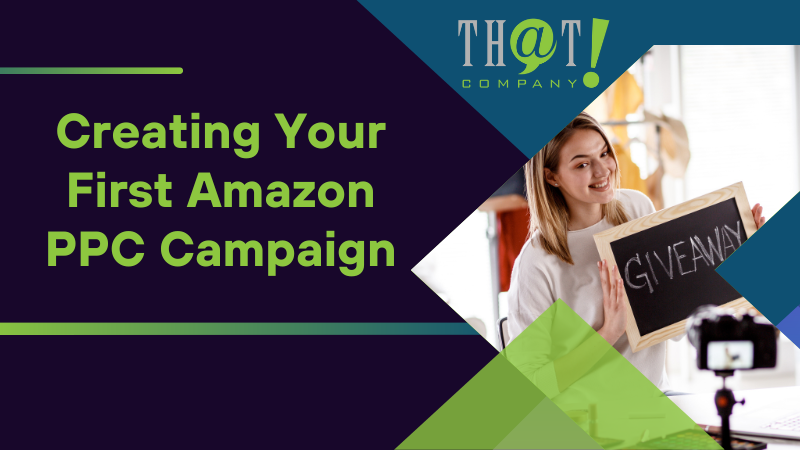
Creating Your First Amazon PPC Campaign
Having established the foundation, we can now establish your inaugural Amazon PPC campaign. Establishing a campaign encompasses the following steps:
- Choosing an ad type
- Structuring the campaign
- Deciding on a budget
- Making bids
While it may sound overwhelming, it’s a straightforward process once you understand each step.
Your marketing objectives and target demographic dictate the selection of ad type. For instance, Sponsored Product ads might be the perfect fit if you want to promote a single product. When it comes to the campaign structure, it’s crucial to organize your campaigns effectively for efficient management. Lastly, setting a realistic budget and competitive bids can ensure your ads are displayed to potential customers.
Selecting Ad Type
Selecting the right ad type is pivotal in setting up your Amazon PPC campaign. Amazon offers a variety of ad types, including Sponsored Product ads, Sponsored Brands, and Sponsored Display ads. Each ad type has unique advantages and is designed to serve different purposes and strategies.
For instance, Sponsored Product ads, the most common type of Amazon PPC ad, are designed to promote individual product listings. These ads can appear in search results and product pages, making them highly visible to potential customers. On the other hand, Sponsored Brands ads allow you to increase brand awareness by promoting your brand and a selection of your products. By understanding the different ad types and their functions, you can select the one that best meets your campaign goals and target audience.
Setting up Campaign Structure
Having chosen the appropriate ad type, you should organize your campaign structure as the next phase in setting up your Amazon PPC campaign. This involves creating ad groups, subsets of your campaign that contain closely related ads and keywords. Organizing your campaign structure is like setting up a well-structured filing system – it makes managing and optimizing your ads much easier.
An important part of setting up your campaign structure is naming your campaign. It’s recommended to use a format like [Product Type] [Duration] [Goal] to help you easily identify the campaign purpose. For example, if you’re running a month-long campaign to promote your new line of yoga mats, you might name your campaign “Yoga Mats May Launch.” This clear and descriptive naming convention makes tracking and managing your campaigns easy.
Budget and Bids
Setting up the budget and bids is essential to creating your Amazon PPC campaign. Here are some key points to consider:
- Your budget is the amount you plan to allocate daily to your campaign.
- Your bids represent the maximum sum you’ll pay when a user clicks on your ad.
- Setting a realistic budget that aligns with your marketing goals and doesn’t break the bank is important.
Regarding bidding, Amazon PPC operates on a second-price auction model, where the winning bid is the second-highest bid plus $0.01. This means you don’t necessarily pay your maximum bid for each click. You can adjust your bids based on the performance of your keywords, increasing bids for high-performing keywords and reducing bids or pausing underperforming ones. This level of control allows you to optimize your ad spend and maximize your ROI.

Optimizing Your Amazon PPC Campaign
Establishing your Amazon PPC campaign merely marks the start. The real work lies in optimizing your campaign for the best possible results. This involves monitoring performance metrics, adjusting bids and budgets, and refining keyword targeting. Regularly analyzing and optimizing your campaign can improve its performance and ensure it delivers a strong return on investment.
Tracking performance metrics is a vital aspect of campaign optimization. Crucial metrics like:
- impressions
- clicks
- cost per click (CPC)
- conversion rate
These yield valuable insights into your campaign’s performance, informing your optimization efforts. Similarly, adjusting bids and budgets based on campaign performance allows you to maximize the effectiveness of your ad spend. Lastly, refining keyword targeting ensures your ads are displayed to the most relevant audience, boosting their effectiveness.
Monitoring Performance Metrics
Keeping a close eye on your campaign’s performance metrics is crucial in optimizing your Amazon PPC campaign. These metrics give you a clear picture of how your campaign is performing and where improvements can be made. For instance, if your ads are getting a lot of impressions but few clicks, it might indicate that your ad copy or images aren’t compelling enough to entice users to click.
Tools like SellerApp Stream, AiHello, and Mayple’s Amazon PPC Software can assist in monitoring your campaign’s performance metrics. With these tools, you can track, in real-time, key performance indicators such as:
- impressions
- clicks
- cost per click (CPC)
- conversion rate
You can also set up alerts to notify you of any significant changes in these metrics, allowing you to respond quickly and adjust your campaign as needed.
Adjusting Bids and Budgets
An essential aspect of Amazon PPC campaign optimization is adjusting bids and budgets. Regularly reviewing your campaign performance and making necessary adjustments can maximize your return on ad spend (ROAS) and ensure your campaign remains profitable.
There are several strategies you can use to optimize your bids. For instance, the Inch Up Method involves gradually increasing your bids to find the optimal bid amount, while the Fast and Sloppy Method involves starting with high bids and then gradually reducing them until you find the optimal bid amount.
On the other hand, adjusting your budget involves allocating more to high-performing campaigns and reducing the budget for underperforming campaigns.
Refining Keyword Targeting
Keyword targeting acts as a guiding compass for your Amazon PPC campaign. It ensures your ads are displayed to the right audience at the right time. Therefore, regularly refining your keyword targeting is crucial for maximizing the effectiveness of your campaign.
High impressions, a good click-through rate, a high conversion rate, and a low ACoS value usually characterize high-performing keywords. On the other hand, underperforming keywords can be identified by filtering out keywords with extremely low performance using the ACoS filter. Once you’ve identified these keywords, you can update your keyword targeting to focus on high-performing keywords and exclude underperforming ones. This will ensure your ads are displayed to the most relevant audience, thereby boosting their effectiveness and your campaign’s ROI.

Scaling Your Amazon PPC Campaigns
Once you’ve set up and optimized your Amazon PPC campaign, the next step is to scale it. Scaling entails:
- Broadening your campaign to engage a larger audience and generate increased sales
- Expanding ad types and targeting
- Leveraging seasonality and promotions
- Outsourcing your PPC management
Expanding ad types and targeting entails experimenting with various ad types and alternatives to reach a wider audience. For instance, you might experiment with Sponsored Display ads to reach customers on and off Amazon. Leveraging seasonality and promotions involves adapting your campaign to align with seasonal trends and special events, which can lead to improved performance and more effective use of your advertising budget. Finally, outsourcing your PPC management to a professional agency like That! Company can save you time and resources, allowing you to focus on other aspects of your business.
Expanding Ad Types and Targeting
Experimenting with different ad types and targeting options is a great way to expand your Amazon PPC campaign. Each ad type has unique benefits and functions, so testing different ad types can help you identify the most effective strategies for your products and audience.
Targeting options include:
- Keyword targeting with match types (broad match, phrase match, exact match)
- Product targeting by individual products or categories
- Filtering options based on price, rating, or brand
By expanding your targeting options, you can reach a larger audience and increase the visibility of your products. Remember, the goal is to reach as many potential customers as possible while ensuring your ads are displayed to the most relevant audience.
Leveraging Seasonality and Promotions
Seasonality and promotions offer unique opportunities to boost your Amazon PPC campaign’s performance. Online shopping peak seasons usually occur during periods like Black Friday and the day after Thanksgiving, when consumers are more likely to purchase.
By adapting your campaigns to align with these trends, you can take advantage of heightened demand and potentially achieve higher sales. Similarly, promotional events such as sales and discounts can attract more customers and increase your conversion rate. Leveraging seasonality and promotions requires careful planning and execution, but the potential benefits make it worthwhile.
Outsourcing PPC Management
Outsourcing your PPC management to a professional agency like That! Company can be a game-changer for your Amazon PPC campaigns. A professional agency has the expertise and resources to:
- Manage and optimize your campaigns effectively
- Conduct keyword research and analysis
- Create compelling ad copy
- Monitor and adjust bids
- Provide detailed reporting and analysis
This frees up your time to focus on other aspects of your business.
That! Company offers comprehensive white label PPC management services, including:
- A dedicated team of experts
- Account manager
- Ongoing campaign analysis and consulting
- Advanced reporting through ConversionTrax technology
- Assistance with the PPC sales cycle by helping with negotiation and handling objections
By outsourcing your PPC management, including white label reputation management, you can ensure your campaigns are in good hands. This allows you to focus on other aspects of your business while expertly handling your online presence and advertising strategies.
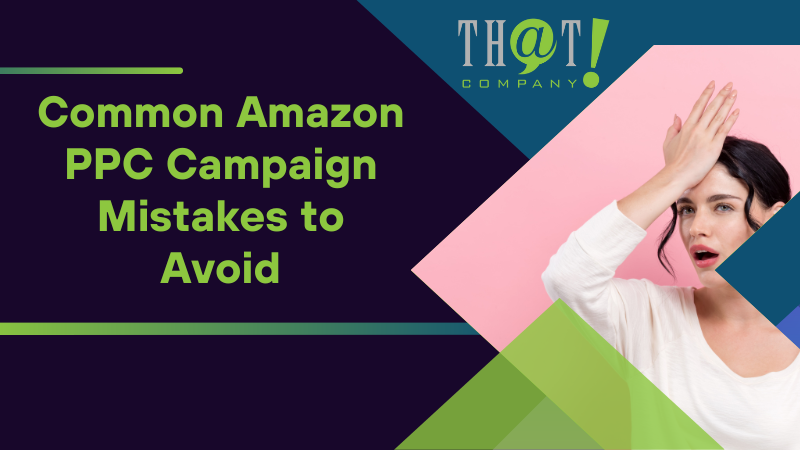
Common Amazon PPC Campaign Mistakes to Avoid
Despite the numerous benefits of Amazon PPC campaigns, sellers commonly make certain mistakes. These mistakes can hinder your campaign’s performance and potentially waste your ad spend. By identifying and avoiding these mistakes, you can ensure your campaign runs smoothly and effectively.
Typical mistakes encompass:
- Poor keyword selection: targeting irrelevant or low-performing keywords can waste your ad spend and reduce your campaign’s effectiveness.
- Neglecting negative keywords: ads displayed for irrelevant searches, potentially leading to wasted ad spend and reduced effectiveness.
- Deficient budget management: inefficient use of your budget and decreased campaign performance.
Poor Keyword Selection
Choosing the right keywords is crucial for the success of your Amazon PPC campaign. Targeting irrelevant or low-performing keywords can waste your ad spend and reduce the effectiveness of your campaign.
Conducting thorough keyword research and regularly monitoring your keyword performance is important to avoid this. By doing so, you can identify high-performing keywords and focus your efforts on targeting these keywords. You can also identify underperforming keywords and exclude them from your campaign, optimizing your keyword targeting and maximizing your campaign’s effectiveness.
Ignoring Negative Keywords
Negative keywords are a powerful tool in Amazon PPC campaigns. They help prevent your ads from appearing in unrelated searches, ensuring your ad spend is not wasted on irrelevant traffic.
However, many sellers overlook the importance of negative keywords, leading to inefficient ad spend and reduced campaign effectiveness. Utilizing negative keywords can refine your campaign and ensure your ads are displayed to the most relevant audience. This can improve your campaign’s performance and maximize your return on ad spend.
Inadequate Budget Management
Managing your budget effectively is crucial for the success of your Amazon PPC campaign. Inadequate budget management can lead to inefficient use of your budget, decreased campaign performance, and adverse effects on sales and product listings.
Monitoring your campaign performance and adjusting your budget accordingly is important to avoid this. This allows you to allocate more budget to high-performing campaigns and reduce the budget for underperforming campaigns. Doing so can optimize your ad spend and maximize your campaign’s effectiveness.

Accelerate Your Agency’s Growth with PPC Services from That! Company
That! Company is a white label marketing agency that provides a comprehensive suite of white label PPC management services, including:
- A dedicated expert team
- An account manager
- Continuous campaign analysis and consulting
- Advanced reporting through ConversionTrax technology
They also assist with the PPC sales cycle by helping with negotiation and handling objections.
What is white label PPC? White label PPC services empower you to expand client relationships, offering additional advertising services under your brand. Showcase the effectiveness of PPC campaigns, furnish branded reports, and establish trust. That! Company’s affordable pricing ensures you can create attractive packages, achieving high-profit margins for your clients.

Summary
We’ve embarked on a journey from understanding Amazon PPC campaigns to mastering managing them. In addition to this, we’ve seen how essential components such as keyword research, ad types, and bidding strategies can make or break a campaign. Then, we learned the importance of monitoring performance metrics, adjusting bids and budgets, and refining keyword targeting to optimize a campaign. We’ve also looked at how to scale a campaign, and the common mistakes to avoid. Lastly, we’ve seen how outsourcing PPC management to a professional agency like That! Company can be a game-changer for your campaigns.
The world of Amazon PPC campaigns can seem complex at first glance, but with the right knowledge, tools, and strategies, you can harness its power to drive traffic, boost sales, and grow your business. Remember, continual learning, testing, analyzing, and optimizing is the key to success. So, gear up and get ready to conquer the Amazon marketplace!
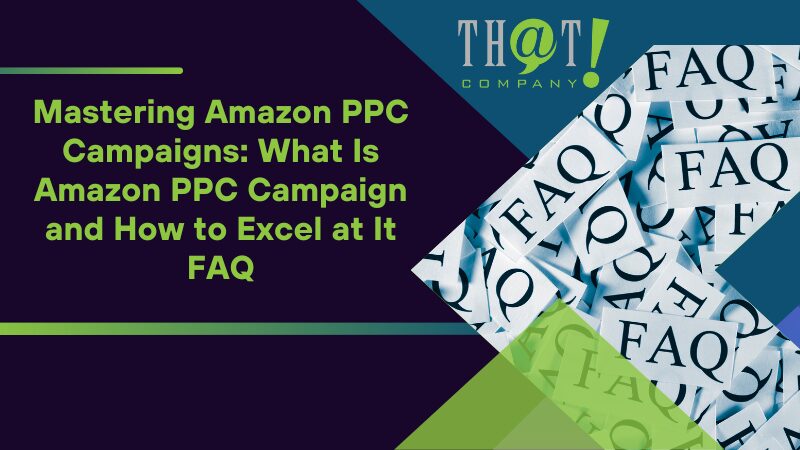
Frequently Asked Questions
How much does a PPC campaign cost for Amazon?
The cost of a PPC campaign for Amazon can range from $0.05 to $10 per click, with the final amount depending on the competitiveness of your niche and the specific product and market.
How does a PPC campaign work?
PPC campaigns work by advertisers paying a publisher each time their ad is clicked, also known as cost-per-click (CPC). This helps advertisers reach their target audience and drive traffic to their websites.
What are the benefits of PPC campaigns on Amazon?
The benefit of Amazon PPC campaigns is the ability to promote products in a highly visible position and target shopping queries or products while offering a flexible budget and detailed metrics to measure effectiveness. This can help improve product visibility and drive sales.
Is Amazon PPC good?
Yes, Amazon PPC is good because it allows you to promote products in a highly visible position, offers budget flexibility, and provides detailed metrics to measure ad effectiveness. Sponsored ads target shopping queries or products, helping to improve visibility and reach customers.
What is an Amazon PPC campaign?
An Amazon PPC campaign is a pay-per-click advertising strategy where sellers pay a fee each time their ad is clicked, boosting product promotion and visibility.






























